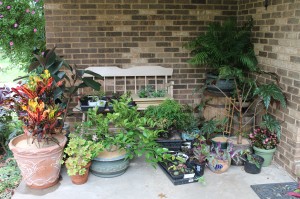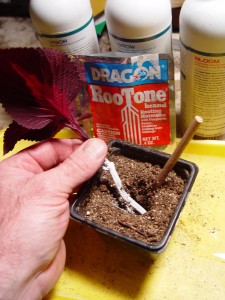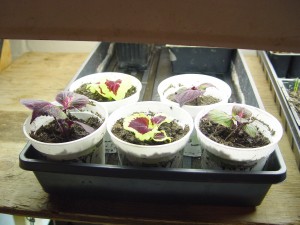Make Your Own Free Plants
October 16th, 2012
Much of the Harrisburg area got at least a partial killing frost overnight last Friday, which knocked out our annuals and other tender plants for the season. That’s actually a couple of weeks earlier than the norm.
If you weren’t ready for the season to come to an end, hopefully you either covered the tender stuff, potted it and brought it inside, or did what I’ve been doing for the last couple of weeks — taking cuttings.
I think back to the peak beauty of these tender things in summer… to how they bloomed their heads off for months… and especially how I sprang for $4.99 a pot for some of them.
I can’t bear to watch it all die off, especially when it’s possible to get “babies” going that will turn out to be my own new next generation next spring.
Getting tip cuttings to root is easier than most people think.
I’ve found it works for a surprising number of plants, and you don’t need a greenhouse, special lighting, rooting hormones or any other complicated stuff. And growing little cuttings inside is easier and takes up much less space than the alternative — digging up the mother plants and taking them inside before cold weather kills them.
The process my wife and I use is pretty simple.
Just snip approximate 6-inch tips from the ends of plants you’d like to keep. Pinch off the lower sets of leaves until you’re left with a bare-legged stick with one or two sets of small leaves at the top.
Next, stick the cuttings into small pots filled with a good-quality, light-weight potting mix. Some people like to dip the lower parts of the cuttings into a rooting hormone such as Rootone first, but I’ve found that most plants I’ve tried root just fine without it.
The idea is to get one — and ideally two — sets of nodes under the ground. A node is the area where those leaves were growing before you pinched them off. This is the part of the cutting where the new roots will emerge. Two sets gives more rooting chances than one set.
Keep the soil damp at all times. It may take several weeks, but if it’s going to work, roots will start growing. Once that happens, you’ve crossed the line from cutting to new baby plant.
At that point, it’s a matter of keeping the young plants alive in winter. I place mine under ordinary fluorescent workshop lights or next to the brightest windows I can find.
Since we usually go hog wild with cuttings (can’t bear to see anything good go down the tubes), we end up filling the lighted space and the good windows in no time and have to move onto any window.
I used to be banned from overwintering cuttings on the new living room floor, but now that Sue has become addicted to cuttings, even that’s OK (albeit with waterproof basins under all pots).
Sure, the plants are going to get leggy over winter and look pretty anemic by mid-winter. No problem. The point is to keep the roots alive.
By late winter, I take new cuttings from the saved stuff. In a few short months, these little plants have gone from life-challenged cutting to baby plant to mother plant. All of the new cuttings go in 4-inch pots, and my favorites go under the lights.
Once they root (which most do), I end up in May with a nice collection of free plants. Keep them damp and give them a little diluted balanced fertilizer.
I move them outside gradually in early May to get them used to more and more light and wind each day over a 7- to 10-day period. Sometimes they’re leggy by then, or they bleach out in the new brighter light.
In those cases, I merely cut back the foliage before planting out in pots or the ground. Within a few weeks, the plants have bushed out and developed new outside-adapted leaves. And by early summer, you can’t tell which plants were do-it-yourself freebies and which were $5 divas from the greenhouse.
It takes a little work, time and plant-moving, but it not only saves a lot of money, it gives you some gardening to do over the dreary winter.
There’s still time to take cuttings from plants that didn’t croak in the frost. It’s cold enough now that you’ll need to move them into the garage or other protected area, though, to keep the soil warm enough to encourage root growth. Under workshop lights also is an option. Remember, the colder the soil, the slower rooting will be (if at all). Definitely do not let your cuttings outside during frost.
The absolute easiest plant to propagate from cuttings: coleus.
I also grow about 8 or 10 Persian shields each winter from cuttings.
Some others that are fairly easy to get going: alternanthera, flowering maple, fuchsia, geraniums, helichrysum, hibiscus, iresine, plectranthus, salvia and some begonias.
But don’t limit yourself to that list. I’ve started plenty of vines and even woody shrubs from cuttings. One thing to keep in mind — watch for patented varieties. Patent protection means that you really shouldn’t make unauthorized copies of a plant — even if you’re just a homeowner growing a few of your own with no intention to sell them or distribute them. More varieties are patented these days than they used to be. Check the plant label when you buy to determine which are patented and which aren’t.
You have little to lose by trying this process. If something doesn’t root, all you’ve wasted is a little time.










